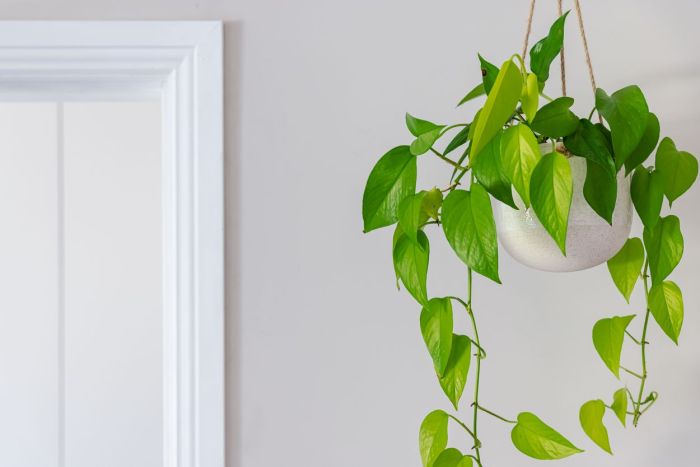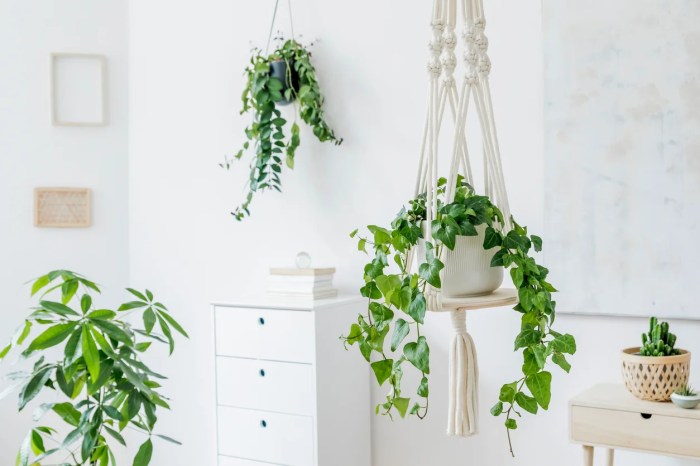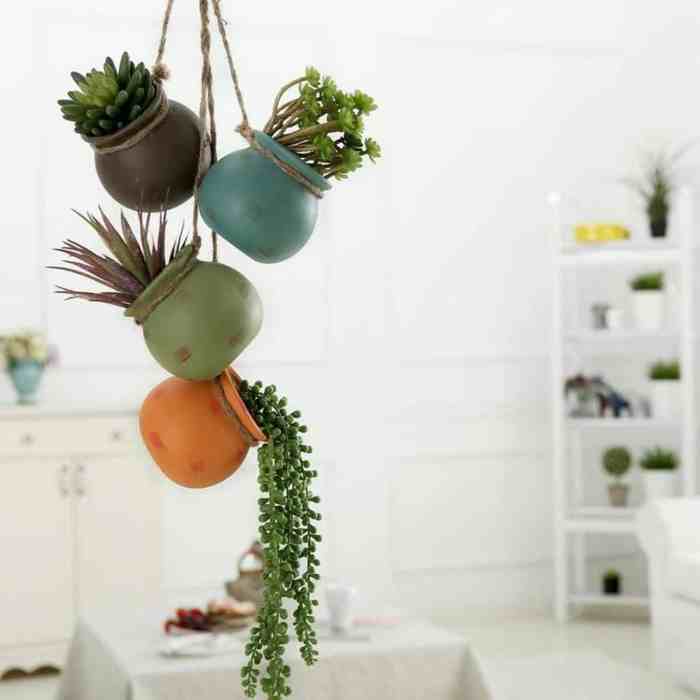Real hanging plants indoor are becoming increasingly popular, offering a unique and stylish way to add greenery and life to your home. These plants not only enhance the aesthetics of your space but also provide numerous benefits, including air purification, stress reduction, and improved mood.
This comprehensive guide will provide you with everything you need to know about real hanging plants indoor, from choosing the right species to troubleshooting common problems. Whether you’re a seasoned plant enthusiast or a novice gardener, this guide will help you create a thriving indoor oasis.
Hanging Plant Varieties
Hanging plants bring a touch of nature and greenery indoors, adding vibrancy and freshness to any space. These plants, with their cascading foliage and unique growth habits, create a sense of tranquility and enhance the overall ambiance of a room.
From lush ferns to trailing vines, a wide range of real hanging plant species are available, each with its own distinct characteristics and care requirements.
Selecting the right hanging plant for your indoor space depends on factors such as the amount of light available, the desired growth habit, and your personal preferences. Here is a comprehensive list of some of the most popular and easy-to-care-for real hanging plant species suitable for indoor environments:
Spider Plant (Chlorophytum comosum)
- Long, arching leaves with variegated green and white stripes
- Produces plantlets (baby spiders) that can be easily propagated
- Prefers bright, indirect light and well-draining soil
Pothos (Epipremnum aureum)
- Trailing vines with heart-shaped leaves in shades of green, yellow, and white
- Tolerant of low light conditions and infrequent watering
- Can be grown in soil or water
String of Pearls (Senecio rowleyanus)
- Delicate trailing vine with pea-shaped, pearl-like leaves
- Prefers bright, indirect light and infrequent watering
- Can be susceptible to overwatering
English Ivy (Hedera helix)
- Vigorous trailing vine with glossy, lobed leaves
- Prefers bright, indirect light and well-draining soil
- Can tolerate lower light conditions but may lose variegation
Ferns (Various species)
- Graceful plants with delicate, feathery fronds
- Prefers bright, indirect light and high humidity
- Water regularly and mist frequently to maintain moisture levels
Wandering Jew (Tradescantia zebrina)
- Trailing vine with variegated leaves in shades of green, purple, and silver
- Tolerant of low light conditions and infrequent watering
- Can be easily propagated from cuttings
Air Plants (Tillandsia species)
- Unique plants that absorb moisture and nutrients from the air
- Do not require soil and can be mounted on various surfaces
- Water by misting or soaking in water for a short period
Benefits of Indoor Hanging Plants
Hanging plants have gained popularity in indoor spaces due to their numerous benefits. These verdant additions not only enhance the aesthetic appeal of a room but also contribute to a healthier and more inviting environment.
One significant advantage of indoor hanging plants is their role in air purification. Certain species, such as the spider plant and peace lily, are known to absorb pollutants like formaldehyde and benzene from the air. By removing these harmful substances, hanging plants improve indoor air quality and create a healthier atmosphere for occupants.
Stress Reduction
Studies have shown that exposure to plants can reduce stress levels and promote relaxation. The presence of greenery has a calming effect on the mind, reducing feelings of anxiety and promoting a sense of well-being. The vibrant colors and textures of hanging plants create a visually stimulating environment that can uplift the mood and provide a sense of tranquility.
Aesthetic Enhancement, Real hanging plants indoor
Hanging plants are a versatile and stylish way to enhance the decor of any room. They can be used to create a focal point, add a touch of greenery to a corner, or create a living wall. The cascading foliage of hanging plants adds a dynamic element to a space, drawing the eye upward and creating a sense of height.
When searching for the perfect touch to liven up any indoor space, real hanging plants are a fantastic choice. From cascading greenery to vibrant blooms, these natural wonders bring a touch of the outdoors inside. For those seeking inspiration, hanging house plants offer a vast selection of options, each with unique characteristics that can transform a room.
Whether it’s a trailing pothos or a blooming orchid, real hanging plants bring a touch of nature and tranquility to any indoor space.
Their lush greenery can complement a wide range of interior styles, from modern to traditional.
Optimal Growing Conditions

Indoor hanging plants require specific environmental conditions to thrive. Understanding their ideal lighting, temperature, humidity levels, watering techniques, and fertilization schedules is crucial for their well-being and longevity.
Lighting
Most hanging plants prefer bright, indirect light. Avoid placing them in direct sunlight, as it can scorch their leaves. Plants that tolerate lower light conditions include pothos, philodendrons, and ZZ plants.
Temperature
Indoor hanging plants prefer warm temperatures between 65-80°F (18-27°C). Avoid exposing them to cold drafts or extreme temperature fluctuations.
Humidity
Many hanging plants thrive in high humidity environments. Misting them regularly or placing them on a tray filled with pebbles and water can increase humidity levels.
Watering
Allow the top inch of soil to dry out before watering. Overwatering can lead to root rot. Water thoroughly and allow excess water to drain away.
Fertilization
Fertilize hanging plants monthly during the growing season (spring and summer) with a balanced liquid fertilizer diluted to half strength.
Hanging Plant Design Ideas: Real Hanging Plants Indoor

Hanging plants can transform indoor spaces by adding a touch of greenery and freshness. By incorporating innovative and stylish display methods, you can showcase your plants and elevate the overall ambiance of your home.
Experiment with macrame hangers, which provide a bohemian and textural element to your decor. Choose planters made from natural materials like jute, cotton, or bamboo to complement the organic feel of the plants.
Real hanging plants indoor can bring a touch of nature into your home. They can also help to improve air quality and add a touch of personality to your space. If you’re looking for the best indoor hanging plants, be sure to check out our guide to best indoor hanging plants . We’ve got all the information you need to choose the perfect plants for your home.
Wall-Mounted Planters
Wall-mounted planters are a space-saving solution for displaying hanging plants. They come in various shapes, sizes, and materials, allowing you to match them with your existing decor. Consider using metal planters for a modern and industrial touch, or opt for ceramic planters for a more classic and elegant look.
Ceiling Hooks
Ceiling hooks offer a simple and versatile way to suspend hanging plants. They can be used to create vertical gardens or to highlight individual plants as focal points. Choose hooks that are sturdy enough to support the weight of your plants and planters, and experiment with different hanging heights to create a dynamic display.
Troubleshooting Common Problems

Indoor hanging plants bring beauty and tranquility to homes, but they may encounter challenges that require attention. Understanding and addressing these issues is crucial for maintaining healthy and thriving plants.
Common problems that may arise include yellowing leaves, pests, and stunted growth. Each issue has specific causes and requires tailored solutions.
Yellowing Leaves
Yellowing leaves can indicate various problems, including nutrient deficiencies, overwatering, underwatering, or excessive sunlight.
- Nutrient deficiency:Feed plants regularly with a balanced fertilizer.
- Overwatering:Allow soil to dry out between waterings. Repot into a pot with drainage holes if necessary.
- Underwatering:Water plants deeply when soil feels dry to the touch.
- Excessive sunlight:Move plants to a shadier location or provide filtered sunlight.
Pests
Pests such as aphids, spider mites, and mealybugs can infest hanging plants. Early detection and treatment are essential.
- Aphids:Spray with insecticidal soap or neem oil.
- Spider mites:Increase humidity around plants or use a miticide.
- Mealybugs:Wipe off with rubbing alcohol or use a systemic insecticide.
Stunted Growth
Stunted growth can be caused by insufficient light, improper soil, or rootbound conditions.
- Insufficient light:Move plants to a brighter location or provide artificial lighting.
- Improper soil:Repot using well-draining potting mix.
- Rootbound conditions:Repot into a larger container with fresh potting mix.
Conclusion
Incorporating real hanging plants indoor is an excellent way to transform your living space into a serene and inviting haven. With careful selection, proper care, and a touch of creativity, you can enjoy the beauty and benefits of these living wonders for years to come.
FAQ Section
What are the best real hanging plants indoor for beginners?
Some of the best real hanging plants indoor for beginners include pothos, spider plants, and philodendrons. These plants are relatively easy to care for and can tolerate a wide range of light conditions.
How often should I water my real hanging plants indoor?
The frequency of watering will vary depending on the type of plant, the size of the pot, and the humidity of your home. As a general rule, most hanging plants should be watered once or twice a week.
What are some common problems that can affect real hanging plants indoor?
Some common problems that can affect real hanging plants indoor include yellowing leaves, pests, and stunted growth. These problems can usually be resolved by adjusting the watering schedule, providing more light, or treating the plant for pests.